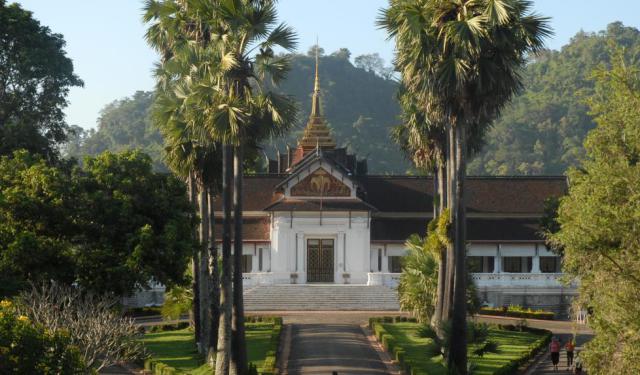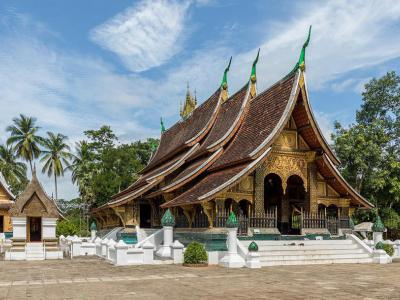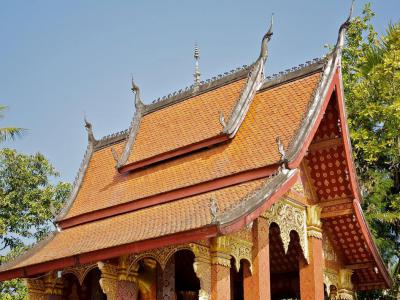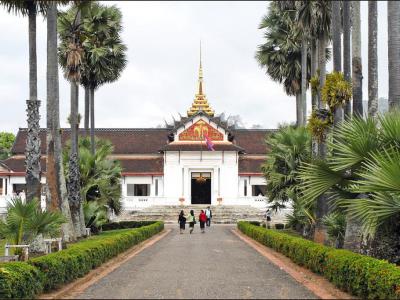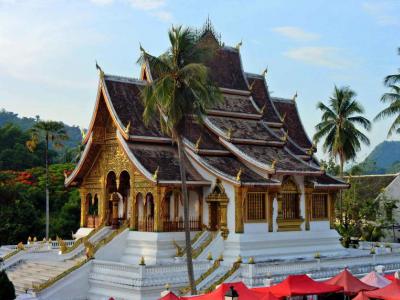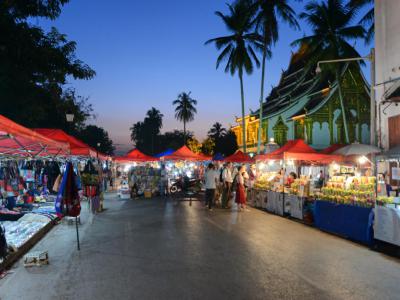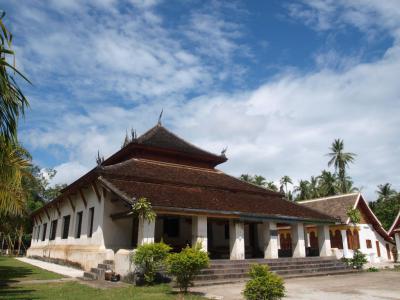Luang Prabang Introduction Walking Tour (Self Guided), Luang Prabang
Initially founded as a city-state in the 8th century AD, Luang Prabang served as a religious center spreading Buddhism introduced to the region by Sri Lankan missionaries. Centuries on, their legacy is still alive in the abundance of Buddhist temples, known as Wats. Among them are the magnificent gilded 16th-century Wat Xieng Thong, the former residence of the Laotian chief Buddhist; the Wat Mai Suwannaphumaham, one of Luang Prabang's largest and most important places of worship; and the Wat Wisunalat, otherwise known as Wat Visoun ("Watermelon Stupa"), one of the oldest temples in the city.
In the 14th century, Luang Prabang became the capital of the Kingdom of Lan Xang, under the rule of King Fa Ngum, who brought to the city one of its most revered religious relics – the golden Buddha statue, known as the Phra Bang.
It is partially due to this statue that Luang Prabang got its name. The first word – "Luang" – means "royal" or "great" in Lao, indicating the city's historical status as a royal capital.
Located at the confluence of the Mekong and Nam Khan rivers, Luang Prabang prospered as a trade hub, attracting merchants from China, Vietnam, and other neighboring countries.
During the 19th and 20th centuries, the city came under French colonial rule. The French influence is still visible in its architecture, particularly in the colonial buildings that blend with traditional Lao structures. After Laos gained independence in 1953, Luang Prabang became the royal capital until 1975, when the monarchy was overthrown.
Standing out amid the plethora of local attractions is the Royal Palace Museum, offering a glimpse into the country's royal history and traditional Lao art. Also notable is the Hmong Night Market along Sisavangvong Road (or Foreigners Street). The latter is one of the main streets in Luang Prabang's old town and an attraction in its own right, lined with cafes, restaurants, shops, and guesthouses catering to tourists.
For years, Luang Prabang's beauty and allure have inspired travelers, writers, and poets to express their admiration of it as “the heart and soul of Laos.” Indeed, the city captures the imagination and steals the heart of all who visit it, immersing them in the spirit of old Indochina. If you wish to feel the sense of timelessness and preservation that defines Luang Prabang, take this self-guided walk.
In the 14th century, Luang Prabang became the capital of the Kingdom of Lan Xang, under the rule of King Fa Ngum, who brought to the city one of its most revered religious relics – the golden Buddha statue, known as the Phra Bang.
It is partially due to this statue that Luang Prabang got its name. The first word – "Luang" – means "royal" or "great" in Lao, indicating the city's historical status as a royal capital.
Located at the confluence of the Mekong and Nam Khan rivers, Luang Prabang prospered as a trade hub, attracting merchants from China, Vietnam, and other neighboring countries.
During the 19th and 20th centuries, the city came under French colonial rule. The French influence is still visible in its architecture, particularly in the colonial buildings that blend with traditional Lao structures. After Laos gained independence in 1953, Luang Prabang became the royal capital until 1975, when the monarchy was overthrown.
Standing out amid the plethora of local attractions is the Royal Palace Museum, offering a glimpse into the country's royal history and traditional Lao art. Also notable is the Hmong Night Market along Sisavangvong Road (or Foreigners Street). The latter is one of the main streets in Luang Prabang's old town and an attraction in its own right, lined with cafes, restaurants, shops, and guesthouses catering to tourists.
For years, Luang Prabang's beauty and allure have inspired travelers, writers, and poets to express their admiration of it as “the heart and soul of Laos.” Indeed, the city captures the imagination and steals the heart of all who visit it, immersing them in the spirit of old Indochina. If you wish to feel the sense of timelessness and preservation that defines Luang Prabang, take this self-guided walk.
How it works: Download the app "GPSmyCity: Walks in 1K+ Cities" from Apple App Store or Google Play Store to your mobile phone or tablet. The app turns your mobile device into a personal tour guide and its built-in GPS navigation functions guide you from one tour stop to next. The app works offline, so no data plan is needed when traveling abroad.
Luang Prabang Introduction Walking Tour Map
Guide Name: Luang Prabang Introduction Walking Tour
Guide Location: Laos » Luang Prabang (See other walking tours in Luang Prabang)
Guide Type: Self-guided Walking Tour (Sightseeing)
# of Attractions: 9
Tour Duration: 2 Hour(s)
Travel Distance: 3.0 Km or 1.9 Miles
Author: Cathy
Sight(s) Featured in This Guide:
Guide Location: Laos » Luang Prabang (See other walking tours in Luang Prabang)
Guide Type: Self-guided Walking Tour (Sightseeing)
# of Attractions: 9
Tour Duration: 2 Hour(s)
Travel Distance: 3.0 Km or 1.9 Miles
Author: Cathy
Sight(s) Featured in This Guide:
- Wat Xieng Thong (Temple of the Golden City)
- Wat Sensoukarahm (Temple of the Patriarch)
- Royal Palace National Museum
- Haw Pha Bang
- Wat Mai Suwannaphumaham (New Golden Land Monastery)
- Hmong Night Market
- Traditional Arts and Ethnology Centre
- Wat Wisunalat (Wisunalat Temple)
- Sisavangvong Road (Foreigners Street)
1) Wat Xieng Thong (Temple of the Golden City) (must see)
Temple of the Golden City (Wat Xieng Thong) is a significant Buddhist temple situated on the northern tip of the peninsula in Luang Prabang. Constructed in 1560 under the patronage of King Setthathirath during the Kingdom of Laos, it holds great historical and religious importance.
The temple was strategically placed near the majestic Mekong River, mirroring the location of the royal palace. Over the years, additional structures were added to the complex, enhancing its grandeur. In 1880, the Tripitaka Library was incorporated, providing a space for preserving Buddhist scriptures. Subsequently, in 1961, the drum tower was constructed, adding to the architectural splendor of the temple.
The Temple of the Golden City consists of several small halls and stupas, each containing Buddha images from the era in which the temple was built. One notable feature is the reclining Buddha sanctuary, which houses an exceptionally rare reclining Buddha statue dating back to the temple's construction. This sacred image holds immense significance and has an intriguing history. In 1931, the statue was transported to Paris and showcased at the Paris Exhibition. It remained in Vientiane until 1964 when it was returned to Luang Prabang, finding its rightful place within the temple once again.
Within the temple compound, near the eastern gate, stands the royal funerary carriage house. This grand structure serves as the final resting place for the funeral carriage and holds various urns containing the remains of members of the royal family. Towering at a height of 12 meters, the carriage house stands as a symbol of honor and respect for the royal lineage.
The Temple of the Golden City embodies the exquisite architectural style and artistic craftsmanship of Laos. The temple showcases intricate carvings, ornate decorations, and beautifully adorned roofs that exemplify the country's traditional aesthetics. The detailed craftsmanship is a testament to the skills and dedication of the artisans who worked on its construction.
The temple was strategically placed near the majestic Mekong River, mirroring the location of the royal palace. Over the years, additional structures were added to the complex, enhancing its grandeur. In 1880, the Tripitaka Library was incorporated, providing a space for preserving Buddhist scriptures. Subsequently, in 1961, the drum tower was constructed, adding to the architectural splendor of the temple.
The Temple of the Golden City consists of several small halls and stupas, each containing Buddha images from the era in which the temple was built. One notable feature is the reclining Buddha sanctuary, which houses an exceptionally rare reclining Buddha statue dating back to the temple's construction. This sacred image holds immense significance and has an intriguing history. In 1931, the statue was transported to Paris and showcased at the Paris Exhibition. It remained in Vientiane until 1964 when it was returned to Luang Prabang, finding its rightful place within the temple once again.
Within the temple compound, near the eastern gate, stands the royal funerary carriage house. This grand structure serves as the final resting place for the funeral carriage and holds various urns containing the remains of members of the royal family. Towering at a height of 12 meters, the carriage house stands as a symbol of honor and respect for the royal lineage.
The Temple of the Golden City embodies the exquisite architectural style and artistic craftsmanship of Laos. The temple showcases intricate carvings, ornate decorations, and beautifully adorned roofs that exemplify the country's traditional aesthetics. The detailed craftsmanship is a testament to the skills and dedication of the artisans who worked on its construction.
2) Wat Sensoukarahm (Temple of the Patriarch)
The Temple of the Patriarch (Wat Sensoukarahm) holds a significant place in the historical and architectural landscape of Luang Prabang. It was constructed during the reign of Chao Kingkitsarat, the first ruler of the independent kingdom of Luang Prabang, which is believed to have taken place between 1706-1713 or 1725.
The temple's origins and establishment are attributed to an individual named Tia Tiao, although it remains unclear whether this person was a member of the royal family, a nobleman, or a prominent figure within the Buddhist sangha.
The main structure of the temple is the sim, or assembly hall, which follows the architectural style classified as Luang Prabang Style II by UNESCO. It features interior columns that are taller than those on the periphery and includes a veranda in front of the main hall. However, the sim exhibits a stronger Thai influence compared to most temples in Luang Prabang. Its distinctive rooftop adorned with bargeboards, eave finials, and vibrant orange/yellow terracotta roof tiles bears resemblance to the architectural styles found in Thailand, particularly in the former Lanna kingdom to the north.
In addition to the sim, the Temple of the Patriarch encompasses more than a dozen structures within its monastery complex. These structures include living quarters for monks, an open pavilion located north of the sim, small Buddha chapels, a drum tower, several stupas, and even a boat shelter. Situated alongside Sakkarine Road, the main east-west road in central Luang Prabang, the temple attracts numerous tourists due to its central location and accessibility.
While the sim is often kept closed, its exterior is visually striking with bright red paint embellished with intricate gold stenciling. The stenciled designs feature Buddhist deities standing on the backs of horses and lions while holding lotus blossoms, adding a sense of grandeur to the temple's facade. The windows of the sim are adorned with Khmer-style wooden balustrades and wooden shutters, intricately stenciled with images of standing deities amidst foliate garlands. This motif is further expressed in three-dimensional relief on the doors of the sim, showcasing the attention to detail and artistic craftsmanship.
The temple's origins and establishment are attributed to an individual named Tia Tiao, although it remains unclear whether this person was a member of the royal family, a nobleman, or a prominent figure within the Buddhist sangha.
The main structure of the temple is the sim, or assembly hall, which follows the architectural style classified as Luang Prabang Style II by UNESCO. It features interior columns that are taller than those on the periphery and includes a veranda in front of the main hall. However, the sim exhibits a stronger Thai influence compared to most temples in Luang Prabang. Its distinctive rooftop adorned with bargeboards, eave finials, and vibrant orange/yellow terracotta roof tiles bears resemblance to the architectural styles found in Thailand, particularly in the former Lanna kingdom to the north.
In addition to the sim, the Temple of the Patriarch encompasses more than a dozen structures within its monastery complex. These structures include living quarters for monks, an open pavilion located north of the sim, small Buddha chapels, a drum tower, several stupas, and even a boat shelter. Situated alongside Sakkarine Road, the main east-west road in central Luang Prabang, the temple attracts numerous tourists due to its central location and accessibility.
While the sim is often kept closed, its exterior is visually striking with bright red paint embellished with intricate gold stenciling. The stenciled designs feature Buddhist deities standing on the backs of horses and lions while holding lotus blossoms, adding a sense of grandeur to the temple's facade. The windows of the sim are adorned with Khmer-style wooden balustrades and wooden shutters, intricately stenciled with images of standing deities amidst foliate garlands. This motif is further expressed in three-dimensional relief on the doors of the sim, showcasing the attention to detail and artistic craftsmanship.
3) Royal Palace National Museum (must see)
The Royal Palace National Museum in Luang Prabang is a significant historical and cultural landmark. Built in 1904 during the French colonial period, it was originally designed as a residence for King Sisavang Vong and his family. Strategically located, it allowed important visitors arriving by the river to directly access the palace for formal receptions. After the monarchy was dissolved in 1975, the building was repurposed as a national museum.
The museum’s architecture is a striking mix of traditional Lao elements and French Beaux Arts style. Its structure is shaped like a double-cruciform, with the main entrance on the lower crossbar. Prominently displayed above the entrance is a three-headed elephant, an emblem of the Lao monarchy, protected by a sacred white parasol.
Inside, the King's reception room, located to the right of the entrance, displays busts celebrating Laos' royal history. This room features two ornate Ramayana screens made by local craftsman Thit Tanh. These screens, rich in detail, depict scenes from the Hindu epic Ramayana and are considered significant artistic and cultural artifacts.
To the left, the secretary’s reception room offers insights into Laos’ diplomatic history through a collection of paintings, silverware, and china received as diplomatic gifts.
The highlight of the museum is the throne room, which houses the Crown Jewels of Laos. These treasures symbolize the splendor and rich heritage of the Lao monarchy and provide a window into the luxurious lifestyle of the past.
The museum’s architecture is a striking mix of traditional Lao elements and French Beaux Arts style. Its structure is shaped like a double-cruciform, with the main entrance on the lower crossbar. Prominently displayed above the entrance is a three-headed elephant, an emblem of the Lao monarchy, protected by a sacred white parasol.
Inside, the King's reception room, located to the right of the entrance, displays busts celebrating Laos' royal history. This room features two ornate Ramayana screens made by local craftsman Thit Tanh. These screens, rich in detail, depict scenes from the Hindu epic Ramayana and are considered significant artistic and cultural artifacts.
To the left, the secretary’s reception room offers insights into Laos’ diplomatic history through a collection of paintings, silverware, and china received as diplomatic gifts.
The highlight of the museum is the throne room, which houses the Crown Jewels of Laos. These treasures symbolize the splendor and rich heritage of the Lao monarchy and provide a window into the luxurious lifestyle of the past.
4) Haw Pha Bang
Haw Pha Bang is a notable religious and cultural monument steeped in history and significance. The temple's name is derived from the sacred Pha Bang Buddha image, which is housed within its walls.
The construction of Haw Pha Bang dates back to the early 19th century, during the reign of King Manthaturath, but the temple has undergone various renovations and additions over the years. It was initially built to enshrine the Pha Bang Buddha, which is considered a revered and sacred religious artifact. The Pha Bang Buddha image itself is believed to have been created in the 14th century and holds great spiritual importance to the people of Luang Prabang.
Architecturally, Haw Pha Bang showcases a blend of traditional Lao and French colonial influences. The temple features intricate carvings, ornate decorations, and a beautifully adorned roof, exemplifying the country's rich artistic heritage. The facade of the temple is adorned with detailed motifs, and the main entrance is often guarded by mythical Naga serpents, which are significant in Lao mythology.
Inside Haw Pha Bang, visitors can explore the sacred space and witness the Pha Bang Buddha image. The statue, which is made of precious metals and adorned with jewels, is believed to bring prosperity and protection to the people of Luang Prabang. The interior of the temple is adorned with intricate murals and religious art, providing a serene and contemplative atmosphere for worshippers and visitors alike.
The construction of Haw Pha Bang dates back to the early 19th century, during the reign of King Manthaturath, but the temple has undergone various renovations and additions over the years. It was initially built to enshrine the Pha Bang Buddha, which is considered a revered and sacred religious artifact. The Pha Bang Buddha image itself is believed to have been created in the 14th century and holds great spiritual importance to the people of Luang Prabang.
Architecturally, Haw Pha Bang showcases a blend of traditional Lao and French colonial influences. The temple features intricate carvings, ornate decorations, and a beautifully adorned roof, exemplifying the country's rich artistic heritage. The facade of the temple is adorned with detailed motifs, and the main entrance is often guarded by mythical Naga serpents, which are significant in Lao mythology.
Inside Haw Pha Bang, visitors can explore the sacred space and witness the Pha Bang Buddha image. The statue, which is made of precious metals and adorned with jewels, is believed to bring prosperity and protection to the people of Luang Prabang. The interior of the temple is adorned with intricate murals and religious art, providing a serene and contemplative atmosphere for worshippers and visitors alike.
5) Wat Mai Suwannaphumaham (New Golden Land Monastery)
New Golden Land Monastery (Wat Mai Suwannaphumaham) is a cornerstone of cultural and spiritual life in Luang Prabang. Established in 1796 by King Anurat, the temple underwent significant enhancements under King Manthathourat, who adorned it with elaborate architectural and decorative elements, earning its current name. This title reflects its importance and the magnificence embedded in its structure and decorations.
As the largest temple in Luang Prabang, the New Golden Land Monastery stands out for its stunning facade, which is richly decorated with scenes from Buddhist mythology. These detailed carvings not only enhance the temple’s aesthetic appeal but also serve an educational purpose, illustrating the teachings and storied history of Buddhism. This ornamental approach allows the temple to act as a canvas that narrates the profound narratives central to Buddhist theology and philosophy.
Historically, the temple has been a pivotal religious site in the city, primarily due to its once housing the most revered Buddha image in Luang Prabang. This sacred artifact drew countless devotees and pilgrims, adding to the temple's status as a spiritual beacon. Today, the New Golden Land Monastery remains a symbol of religious devotion and Laotian heritage, offering both worshippers and tourists a place for reflection, prayer, and appreciation of its historical and artistic grandeur.
As the largest temple in Luang Prabang, the New Golden Land Monastery stands out for its stunning facade, which is richly decorated with scenes from Buddhist mythology. These detailed carvings not only enhance the temple’s aesthetic appeal but also serve an educational purpose, illustrating the teachings and storied history of Buddhism. This ornamental approach allows the temple to act as a canvas that narrates the profound narratives central to Buddhist theology and philosophy.
Historically, the temple has been a pivotal religious site in the city, primarily due to its once housing the most revered Buddha image in Luang Prabang. This sacred artifact drew countless devotees and pilgrims, adding to the temple's status as a spiritual beacon. Today, the New Golden Land Monastery remains a symbol of religious devotion and Laotian heritage, offering both worshippers and tourists a place for reflection, prayer, and appreciation of its historical and artistic grandeur.
6) Hmong Night Market (must see)
The Hmong Night Market in the center of Luang Prabang has become an iconic and bustling attraction that opens its doors to visitors every evening around 5 o'clock. Originally intended to last only a few weeks, the market came into existence on a significant occasion - the Occidental Christmas Eve in December 2002. Hmong artisans and craftsmen, along with others from the region, showcased their traditional products to eager tourists seeking unique gifts. In those early days, the market was illuminated by candlelight, adding to its charm and creating a special ambiance.
However, what was initially meant to be a temporary market soon took on a life of its own. Today, the Hmong Night Market has expanded significantly, boasting hundreds of stalls. Visitors can explore a diverse array of products, ranging from ornamental stone chess games to silk scarves, intricately embroidered items, sculptures, opium pipes, Buddha figurines in various forms, local paintings depicting symbolic Buddhist representations, and much more. It's a treasure trove of handmade crafts and traditional artworks, offering a glimpse into the rich cultural heritage of the region.
The market is particularly renowned for its variety of traditional food and ingredients, allowing visitors to experience the authentic flavors of Laos. From delicious street food such as fried mushrooms, spring rolls, and baked goods to local beverages like Lao Lao whiskey or Beerlao, there's something to satisfy every palate. The market provides an excellent opportunity to indulge in the local cuisine at affordable prices.
Bargaining is a customary practice at the Hmong Night Market and adds an element of excitement to the shopping experience. However, unlike their Thai, Chinese, or Vietnamese counterparts, Laotians are not skilled in the art of bargaining and are less likely to exploit tourists with exorbitant prices. Visitors should be cautious not to drive prices below the cost prices, as it may inadvertently worsen the local poverty situation. It's important to strike a fair deal while considering the livelihoods of the storekeepers, who may not excel in accounting practices in this part of the world.
However, what was initially meant to be a temporary market soon took on a life of its own. Today, the Hmong Night Market has expanded significantly, boasting hundreds of stalls. Visitors can explore a diverse array of products, ranging from ornamental stone chess games to silk scarves, intricately embroidered items, sculptures, opium pipes, Buddha figurines in various forms, local paintings depicting symbolic Buddhist representations, and much more. It's a treasure trove of handmade crafts and traditional artworks, offering a glimpse into the rich cultural heritage of the region.
The market is particularly renowned for its variety of traditional food and ingredients, allowing visitors to experience the authentic flavors of Laos. From delicious street food such as fried mushrooms, spring rolls, and baked goods to local beverages like Lao Lao whiskey or Beerlao, there's something to satisfy every palate. The market provides an excellent opportunity to indulge in the local cuisine at affordable prices.
Bargaining is a customary practice at the Hmong Night Market and adds an element of excitement to the shopping experience. However, unlike their Thai, Chinese, or Vietnamese counterparts, Laotians are not skilled in the art of bargaining and are less likely to exploit tourists with exorbitant prices. Visitors should be cautious not to drive prices below the cost prices, as it may inadvertently worsen the local poverty situation. It's important to strike a fair deal while considering the livelihoods of the storekeepers, who may not excel in accounting practices in this part of the world.
7) Traditional Arts and Ethnology Centre
The Traditional Arts and Ethnology Centre is a captivating institution dedicated to preserving and promoting Lao culture and traditions. Since its establishment in 2007, the center has become a renowned destination for both locals and tourists seeking to delve deeper into the rich heritage of the country's diverse ethnicities.
At the Traditional Arts and Ethnology Centre, visitors have the opportunity to explore a vast collection of objects that provide insights into the religious practices, lifestyles, and distinct characteristics of the local communities. The center's exhibits showcase traditional art, handicrafts, clothing, textiles, tools, and various artifacts, each telling a story about the cultural identity and history of Laos.
The center serves as an educational hub, offering valuable information about the unique traditions, customs, and beliefs of different ethnic groups in Laos. It acts as a bridge, fostering understanding and appreciation for the rich cultural tapestry of the country.
In addition to its permanent collection, the Traditional Arts and Ethnology Centre hosts a range of dynamic activities that allow visitors to actively participate, learn traditional crafts, witness traditional performances, and gain a deeper understanding of the customs and rituals practiced by different ethnic communities.
At the Traditional Arts and Ethnology Centre, visitors have the opportunity to explore a vast collection of objects that provide insights into the religious practices, lifestyles, and distinct characteristics of the local communities. The center's exhibits showcase traditional art, handicrafts, clothing, textiles, tools, and various artifacts, each telling a story about the cultural identity and history of Laos.
The center serves as an educational hub, offering valuable information about the unique traditions, customs, and beliefs of different ethnic groups in Laos. It acts as a bridge, fostering understanding and appreciation for the rich cultural tapestry of the country.
In addition to its permanent collection, the Traditional Arts and Ethnology Centre hosts a range of dynamic activities that allow visitors to actively participate, learn traditional crafts, witness traditional performances, and gain a deeper understanding of the customs and rituals practiced by different ethnic communities.
8) Wat Wisunalat (Wisunalat Temple)
Wisunalat Temple (Wat Wisunalat) is not only the oldest Buddhist temple in Luang Prabang but also one of the most renowned attractions in the city. Its rich history, cultural significance, and distinctive architecture make it a must-visit site for tourists.
Originally constructed in 1513 during the reign of King Visoun, who ruled Laos from 1501 to 1520, Wisunalat Temple showcases beautiful architectural elements. However, the temple suffered a devastating fate in 1887 when it was destroyed by the Black Flag Army, a group of marauders of Chinese origin who ravaged Luang Prabang. They looted the temple, carrying away precious Buddha images made of jade, gold, and precious gems, by breaking the stupa that housed them.
Wisunalat Temple holds another notable historical association as it was the original home of the revered Phra Bang Buddha. The Phra Bang Buddha resided in the temple from 1513 until 1707 before being relocated to the Royal Palace Museum. Today, Wisunalat Temple serves as the city's Museum of Religious Arts, preserving the cultural and religious heritage of Luang Prabang.
Inside the temple hall, visitors can admire a small collection of gilded Buddha statues and ancient stones dating back to the 15th century. The hall also features informative plaques in both Lao and English, providing insights into the history and iconography of the Buddhist statues. These plaques offer an opportunity to understand the various poses of the Buddha images and the artistic influences that shaped their design.
One of the prominent features of Wisunalat Temple is its uniquely shaped stupa, which was designed by the wife of King Wisunarat. While intended to resemble a lotus flower, the rounded dome of the stupa has led locals to affectionately refer to it as the "watermelon stupa."
Originally constructed in 1513 during the reign of King Visoun, who ruled Laos from 1501 to 1520, Wisunalat Temple showcases beautiful architectural elements. However, the temple suffered a devastating fate in 1887 when it was destroyed by the Black Flag Army, a group of marauders of Chinese origin who ravaged Luang Prabang. They looted the temple, carrying away precious Buddha images made of jade, gold, and precious gems, by breaking the stupa that housed them.
Wisunalat Temple holds another notable historical association as it was the original home of the revered Phra Bang Buddha. The Phra Bang Buddha resided in the temple from 1513 until 1707 before being relocated to the Royal Palace Museum. Today, Wisunalat Temple serves as the city's Museum of Religious Arts, preserving the cultural and religious heritage of Luang Prabang.
Inside the temple hall, visitors can admire a small collection of gilded Buddha statues and ancient stones dating back to the 15th century. The hall also features informative plaques in both Lao and English, providing insights into the history and iconography of the Buddhist statues. These plaques offer an opportunity to understand the various poses of the Buddha images and the artistic influences that shaped their design.
One of the prominent features of Wisunalat Temple is its uniquely shaped stupa, which was designed by the wife of King Wisunarat. While intended to resemble a lotus flower, the rounded dome of the stupa has led locals to affectionately refer to it as the "watermelon stupa."
9) Sisavangvong Road (Foreigners Street)
Sisavangvong Road, commonly known as Foreigners Street, is the main road and the most prosperous street in Luang Prabang. Stretching through the heart of the city, it offers a vibrant and diverse experience for both locals and tourists.
Along Sisavangvong Road, visitors can explore several prominent attractions. The Palace Museum, which was once the residence of Laos' royal family, stands as a testament to the country's rich history. The magnificent Mai Buddha Temple, located nearby, showcases intricate Buddhist art and architecture. Phu Si Mountain, Shenfo Temple, Xibu Taba Temple, and Hoxiang Temple are also situated along this road, offering spiritual and cultural experiences to those who seek them.
The street is lined with various small shops that sell a wide range of crafts and clothing, allowing visitors to indulge in some local shopping. Additionally, popular restaurants can be found here, offering delicious local and international cuisines.
Sisavangvong Road serves as a hub for various facilities and services. Travel agencies provide assistance for short-distance tourism and foreign exchange services. Hotels, visitor centers, post offices, schools, and police stations are conveniently located along the street. The residences of the daughter-in-law of King IV also adorn this bustling thoroughfare.
During the day, visitors can observe the morning bus and explore the bustling local markets that showcase an array of goods. In the evening, the street transforms into a vibrant night market, with numerous stalls and shops lining both sides. This bustling market offers a unique opportunity to immerse oneself in the local culture, sample traditional delicacies, and purchase handicrafts and souvenirs.
As visitors stroll along Sisavangvong Road, they can admire the architectural blend of Lao characteristics and French influences. The buildings along the street exude a unique charm, reflecting the historical legacy of Laos.
Along Sisavangvong Road, visitors can explore several prominent attractions. The Palace Museum, which was once the residence of Laos' royal family, stands as a testament to the country's rich history. The magnificent Mai Buddha Temple, located nearby, showcases intricate Buddhist art and architecture. Phu Si Mountain, Shenfo Temple, Xibu Taba Temple, and Hoxiang Temple are also situated along this road, offering spiritual and cultural experiences to those who seek them.
The street is lined with various small shops that sell a wide range of crafts and clothing, allowing visitors to indulge in some local shopping. Additionally, popular restaurants can be found here, offering delicious local and international cuisines.
Sisavangvong Road serves as a hub for various facilities and services. Travel agencies provide assistance for short-distance tourism and foreign exchange services. Hotels, visitor centers, post offices, schools, and police stations are conveniently located along the street. The residences of the daughter-in-law of King IV also adorn this bustling thoroughfare.
During the day, visitors can observe the morning bus and explore the bustling local markets that showcase an array of goods. In the evening, the street transforms into a vibrant night market, with numerous stalls and shops lining both sides. This bustling market offers a unique opportunity to immerse oneself in the local culture, sample traditional delicacies, and purchase handicrafts and souvenirs.
As visitors stroll along Sisavangvong Road, they can admire the architectural blend of Lao characteristics and French influences. The buildings along the street exude a unique charm, reflecting the historical legacy of Laos.
The Most Popular Cities
/ view all
